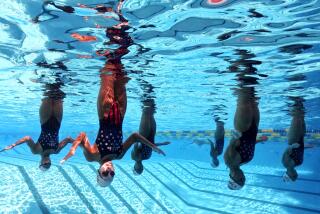Moses Endorses Altitude Training
- Share via
Ed Moses spends a great deal of time at about 7,000 feet -- without ever leaving his room.
The Olympic gold-medal swimmer feels most comfortable in the pool, but he credits a great deal of his success there to his time above the water ... high above the water.
Moses, 24, has been altitude training for two years, using a room that has been modified to simulate the thinner air at high altitude.
Moses said altitude training, generally associated with cyclists and runners, was increasing in popularity among swimmers.
“A lot of Europeans and Australians are doing it and seem to get good results, so if other people are doing it, you’ve got to feel like you are missing the boat if you’re not doing it,” he said. “If your competition is doing it, you’ve got to level the field.”
Altitude training is said to increase the number of red blood cells that transport oxygen to muscles, which, Moses said, increases endurance.
The training became significant for Moses in 2002, after he tore cartilage in both knees. After two surgeries in two months, he was left wondering if he would be able to return to the form that won a gold medal in the 400 medley relay at the Sydney Olympics in 2000.
So he retreated to his altitude room and raised the level to 10,000 feet to offset his less-intense recovery workouts. Today, he says, he’s fully recovered. He showed it Saturday at the Janet Evans Invitational in Long Beach when he set the meet record in the 200-meter breaststroke at 2 minutes 15.39 seconds in a consolation heat.
(Minutes later, Jim Piper of Australia finished in 2:13.43.)
Setting up an altitude room, Moses said, is simple. Generators take the air inside the room, trap some of the oxygen and expel it. Nitrogen-rich air is pumped into the space, which is sealed off with weather stripping.
“It’s not that difficult,” he said. “I could come in and set your room up in 30 minutes.”
More to Read
Go beyond the scoreboard
Get the latest on L.A.'s teams in the daily Sports Report newsletter.
You may occasionally receive promotional content from the Los Angeles Times.






